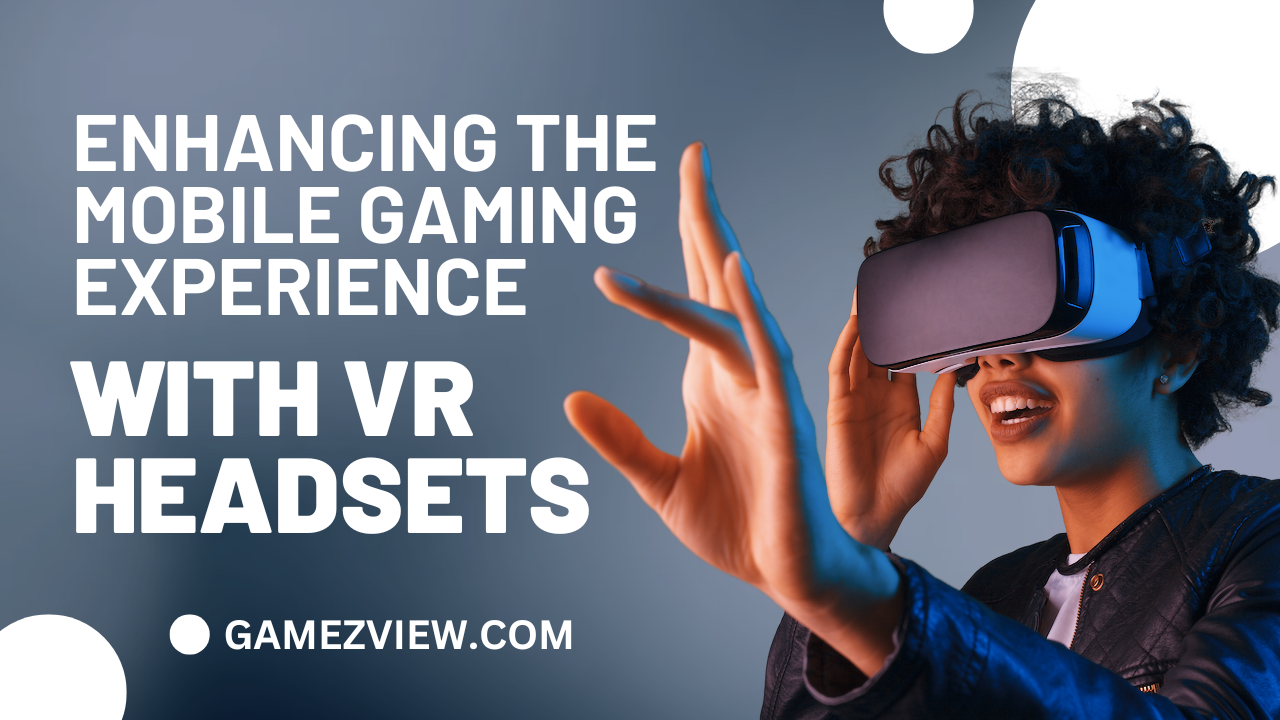Mobile gaming has rapidly evolved from simple games like Snake and Tetris to complex, immersive experiences. With the advent of powerful smartphones, mobile games now rival console and PC games in terms of graphics, gameplay, and storytelling.
The Role of VR in Gaming
Virtual Reality (VR) has been a game-changer in the gaming industry, offering players an immersive experience that traditional gaming setups can’t match. VR’s ability to create a fully immersive environment is revolutionizing how we play games, making the experience more engaging and realistic.
Importance of Combining VR with Mobile Gaming
Combining VR with mobile gaming creates a unique experience that leverages the portability of mobile devices and the immersive nature of VR. This integration allows gamers to enjoy high-quality, immersive games anywhere, anytime, without the need for bulky equipment.
Technical Specifications
Essential VR Headset Features
- Display Quality: High resolution and refresh rate are crucial for a smooth VR experience.
- Field of View: A wider field of view enhances immersion.
- Comfort and Fit: Adjustable straps and padding for extended use.
- Compatibility: Ensuring the headset works seamlessly with various mobile devices.
- Sensors and Tracking: Accurate motion tracking to prevent motion sickness.
Leading VR Headsets for Mobile Gaming
- Oculus Quest 2: Known for its standalone functionality and high performance.
- Google Daydream View: Offers an affordable entry point into mobile VR.
- Samsung Gear VR: Optimized for Samsung phones, providing excellent integration.
- Merge VR: A durable, kid-friendly option that’s compatible with a wide range of smartphones.
Mobile Device Requirements
- Processor Power: High-end processors to handle VR applications.
- RAM: Sufficient memory to run VR games smoothly.
- Display Resolution: Higher resolution screens for a clearer VR experience.
- Battery Life: Extended battery life to support longer gaming sessions.
- Connectivity Options: Bluetooth and USB-C for easy connection to VR headsets.
Applications
Gaming Genres Enhanced by VR
- First-Person Shooters (FPS): Immersive environments and realistic interactions.
- Adventure and Exploration: Allows players to explore vast virtual worlds.
- Puzzle and Strategy Games: Enhances problem-solving by immersing players in the game environment.
- Horror Games: Intensifies the scare factor with a fully immersive experience.
- Simulation Games: Offers realistic simulations of real-world activities.
Popular VR Mobile Games
- “Half-Life: Alyx”: A critically acclaimed game that offers a rich, immersive experience.
- “Beat Saber”: A rhythm game that combines music and lightsaber action.
- “Moss”: An adventure game featuring a small mouse in a big world.
- “Keep Talking and Nobody Explodes”: A cooperative game that requires communication and problem-solving skills.
- “End Space”: A space combat game that leverages VR’s immersive capabilities.
Educational and Training Uses
- Medical Training: Simulating surgeries and medical procedures for students.
- Corporate Training: Virtual environments for skill-building and safety training.
- STEM Education: Interactive learning in subjects like biology, chemistry, and physics.
- Language Learning: Immersive environments for practicing new languages.
Benefits
Enhanced Immersion and Realism
VR headsets create a sense of presence, making players feel as though they are actually inside the game world. This level of immersion enhances the overall gaming experience, making it more engaging and enjoyable.
Improved Cognitive Skills
Playing VR games can improve various cognitive skills, including spatial awareness, hand-eye coordination, and problem-solving abilities. These benefits extend beyond gaming, potentially enhancing everyday cognitive functions.
Increased Physical Activity
Many VR games require physical movement, which can provide a moderate level of exercise. Games like “Beat Saber” and “Superhot VR” encourage players to move, duck, and dodge, promoting physical activity while gaming.
Social Interaction
VR gaming offers unique opportunities for social interaction. Multiplayer VR games allow players to interact with each other in a virtual environment, fostering social connections and teamwork.
Versatility and Portability
Combining VR with mobile gaming makes it possible to enjoy immersive experiences on the go. Mobile VR headsets are lightweight and portable, allowing gamers to take their VR experiences anywhere.
Challenges and Limitations
Technical Challenges
- Performance Issues: Mobile devices may struggle with the demands of high-quality VR games.
- Battery Life: VR gaming can drain the battery quickly, limiting playtime.
- Heat Management: Extended VR sessions can cause devices to overheat.
Health Concerns
- Motion Sickness: Some players experience discomfort and nausea during VR gameplay.
- Eye Strain: Prolonged use can lead to eye fatigue and discomfort.
- Physical Safety: Limited awareness of surroundings can lead to accidental injuries.
Accessibility Issues
- Cost: High-quality VR headsets and compatible devices can be expensive.
- Physical Limitations: Not all players can use VR due to physical disabilities or limitations.
- Space Requirements: Adequate space is needed to safely use VR headsets.
Market Penetration
- Adoption Rate: VR is still in the early stages of widespread adoption.
- Content Availability: The library of VR games and applications is growing but still limited compared to traditional gaming.
Latest Innovations
Advanced Tracking Systems
New tracking technologies, such as inside-out tracking, enhance the accuracy and reliability of VR experiences. These systems eliminate the need for external sensors, making VR more accessible and user-friendly.
Improved Display Technologies
Advancements in display technology, including higher resolution screens and faster refresh rates, significantly improve the visual quality of VR experiences. OLED and AMOLED screens offer better contrast and colour accuracy.
Haptic Feedback and Wearables
Haptic feedback devices and wearables provide physical sensations that enhance immersion. These technologies allow players to feel interactions within the game, such as impacts and vibrations.
AI and Machine Learning Integration
AI and machine learning are being integrated into VR games to create more responsive and adaptive experiences. These technologies can adjust the game difficulty in real time and create more realistic NPC behaviours.
Cloud VR
Cloud VR technology allows games to be streamed from powerful servers, reducing the need for high-end hardware on the user’s end. This development could make high-quality VR experiences more accessible to a broader audience.
Future Prospects
Increased Accessibility
Future advancements are likely to make VR more affordable and accessible. Improvements in hardware and software will reduce costs and make VR more user-friendly.
Integration with Augmented Reality (AR)
The combination of VR and AR, known as mixed reality, will create even more immersive and interactive experiences. This integration will expand the possibilities for gaming, education, and training applications.
Expansion of the VR Ecosystem
As VR technology continues to develop, the ecosystem of compatible games, applications, and devices will grow. This expansion will provide more options and opportunities for users.
Enhanced Social VR Experiences
The future of VR will likely see more sophisticated social platforms where users can interact, work, and play together in virtual environments. These platforms could revolutionize how we connect and collaborate online.
New Business Models
The VR market will see the emergence of new business models, such as subscription services for VR content and hardware. These models will make it easier for users to access the latest VR experiences without significant upfront costs.
Comparative Analysis
VR vs. Traditional Gaming
- Immersion: VR offers a higher level of immersion compared to traditional gaming.
- Accessibility: Traditional gaming is more accessible due to lower hardware requirements.
- Variety: Traditional gaming has a larger library of games and genres.
- Social Interaction: Both platforms offer social interaction, but VR provides more immersive social experiences.
VR vs. Augmented Reality (AR)
- Environment: VR creates a completely virtual environment, while AR overlays digital elements onto the real world.
- Applications: VR is primarily used for gaming and simulations, while AR has broader applications, including navigation and information display.
- Hardware: VR requires more specialized hardware, whereas AR can be used on standard mobile devices.
User Guides or Tutorials
Setting Up Your VR Headset
- Unbox the Headset: Carefully remove all components from the packaging.
- Charge the Headset: Ensure the headset is fully charged before use.
- Install Necessary Apps: Download and install the VR app on your mobile device.
- Pair the Devices: Connect the VR headset to your mobile device via Bluetooth or USB.
- Adjust Fit and Comfort: Use the adjustable straps to fit the headset comfortably on your head.
- Calibrate the Headset: Follow the on-screen instructions to calibrate the headset for optimal performance.
Tips for a Better VR Gaming Experience
- Use High-Quality Headphones: Enhance the immersive experience with surround sound.
- Take Breaks: Regular breaks can prevent eye strain and motion sickness.
- Clear Play Area: Ensure your play area is free of obstacles to avoid accidents.
- Adjust Settings: Fine-tune graphics and performance settings for the best experience.
- Stay Hydrated: Keep water nearby to stay hydrated during extended gaming sessions.
Summary of Key Points
VR headsets significantly enhance the mobile gaming experience by offering immersive and realistic gameplay. The integration of VR with mobile gaming provides unique opportunities for gamers to enjoy high-quality experiences anywhere, anytime. While there are challenges to overcome, such as technical limitations and health concerns, the benefits and prospects of VR in mobile gaming are promising.
Call to Action for Further Education
As VR technology continues to evolve, staying informed about the latest developments and best practices is essential. Explore the vast array of VR games and applications available, and consider investing in a high-quality VR headset to elevate your mobile gaming experience.



